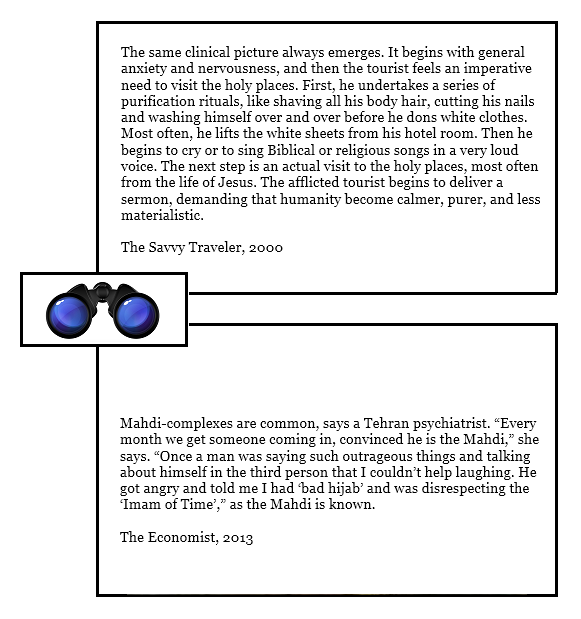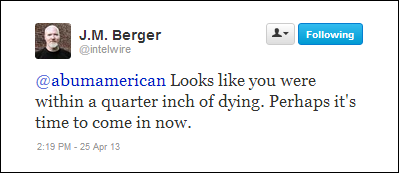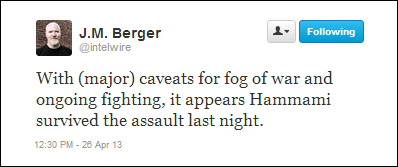[The views and opinions expressed here are solely the responsibility of Lynn C. Rees. They may not necessarily reflect the official views or opinions of Zenpundit]
To deter, Barack Obama has publicly drawn a red line between tolerable and intolerable. We now watch to see and (perhaps) learn if open signaling of red lines has deterrent effect.
Open red lines intended to stave off the intolerable without ending in blows are as ancient as territorial instinct. Red frequents coloration of animals who’ve evolved warning signals embedded in their anatomy. Lines, though marked more by scent or suggested by signal, are also abundant among Man and nature.
“Bear”, my brother’s late Shar-Pei, vociferously defended my brother’s chain-linked fence line. All his toing and froing facing down suspicious pedestrians even wore a second line into the front lawn that paralleled the fence. His vigorous bark emerged from wolven ancestors to draw lines red in tooth and claw in wolven mind so it didn’t come to lines red in tooth and claw in wolven reality.
But, if bluffs are called and barks prove to have more volume than bite, a red line will prove only as substantial as the bite and fight beyond it. If warning is not credibly conveyed and things fall apart, nothing may remain except bite and fight.
Bear’s bark proved a poor red line. While it sounded loud and formidable, when you opened the front gate and entered the yard, Bear would casually mosey up, sniff you, and promptly return to the barking line. Shar Peis are renowned for even-tempers. Bred as guard dogs in China, they often had to be brutalized or drugged into fight and bite. Bear was neither brutalized nor drugged so he lacked credible fierceness.
There is no certain calculus in drawing red lines. My calculus teacher wisely taught that variables have only one invariable certainty: they tend to vary. Man is not only variable, he is contrary. His contrariness not only votes present, it votes with real impact. If it were otherwise, you’d have a sort of Clausewitzian “red line by algebra: tally up one side of a red line in one column and tally the other side in another column. Then, when clearly displayed in public, those on either side would be forced to agree on how substantial the red line was and openly acknowledge its deterrent psychology.
Politics, the division of power, varies most in the intensity in which its division of power escalates confrontation toward violence. Some political contestants’ escalation is too hot. Others’ escalation is too cold. For others, their escalation will be just right. Some draw red lines and aggressively escalate political intensity based on broken red line theory: one small crack in your red line, like someone publicly urinating on it, means the entire red line will be stripped down to its bare chassis overnight if small infractions aren’t predictably and promptly punished. Others use them to draw folks along, perhaps as bait, perhaps as stalling tactics, while they do something else somewhere else. Some red lines are implicitly understood by all as being for entertainment purposes only.
Unfortunately, we’re armed with only a few rules of thumb to guide us in drawing and escalating red lining, most centered on creating intrinsic credibility:
- …every power ought to be commensurate with its object…
- …the means ought to be proportioned to the end…
- …there ought to be no limitation of a power destined to effect a purpose, which is itself incapable of limitation…
- A government ought to contain in itself every power requisite to the full accomplishment of the objects committed to its care, and to the complete execution of the trusts for which it is responsible, free from every other control but a regard to the public good and to the sense of the people.
- As the duties of superintending the national defense and of securing the public peace against foreign or domestic violence involve a provision for casualties and dangers to which no possible limits can be assigned, the power of making that provision ought to know no other bounds than the exigencies of the nation and the resources of the community.
- As revenue is the essential engine by which the means of answering the national exigencies must be procured, the power of procuring that article in its full extent must necessarily be comprehended in that of providing for those exigencies.
Beyond that, it’s a matter of converting intrinsic credibility into fully mobilizable and then field-deployable credibility.
Angelo M. Codevilla writes:John Quincy Adams, a student as well as a practitioner of statesmanship, believed that governments understand their own and others’ interests quite well. His involvement in diplomacy, which lasted from 1778 to the end of his presidency in 1829, convinced him not that negotiations are superfluous, but rather that they ratify the several parties’ recognition of existing realities regardless of agreements or lack thereof. Diplomacy can make it more comfortable to live with reality by clarifying mutual understanding of it. On the other hand, Adams’ magisterial notes on his 1823 recommendation that America spurn the invitation to join Britain in a declaration disapproving any attempt to recover Spain’s American colonies—that jointness would have added nothing to the reality of parallel British and U.S. opposition to such a venture—underlines the central fact about diplomacy: though it conveys reality, it does not amend it.
In 1968, Fred Ikle published How Nations Negotiate, which is used by diplomatic academies around the world. Too many graduates, however, forget its central teaching, which is that the diplomat’s first task is to figure out whether agreement is possible on the basis of “the available terms”—in short, whether both sides’ objectives, though different, are compatible. Only if they are can negotiations proceed according to what Ikle calls “rules of accommodation”—making sincere proposals, honoring partial agreements, etc. If the objectives are incompatible, the diplomats may choose to walk away, or to “negotiate for side effects”—to use the negotiations to undermine the other side’s government, sow dissention among its allies, deceive it, pocket partial agreements and renege on commitments, buy time, gather intelligence, etc. Disaster looms when one side follows the rules of accommodation while the other negotiates for side effects. The essence of Ikle’s teaching is that the negotiator’s primordial job is to judge correctly whether the other side is negotiating for “available terms” or is waging war through diplomatic means, and hence to choose whether to negotiate for agreement, walk away, or treat the diplomatic table as a battlefield. That choice is “perpetual,” he writes, because human motives are variable.
When the president publicly drew his red line:
Michelle and I have used a strategy when it comes to things like tattoos — what we’ve said to the girls is, ‘If you guys ever decide you’re going to get a tattoo, then Mommy and me will get the same exact tattoo in the same place,'” he said. “And we’ll go on YouTube and show it off as a family tattoo. And our thinking is that it might dissuade them from thinking that somehow that’s a good way to rebel.
He’s made his “primordial job” as a parent public. Under public scrutiny, he has to “judge correctly” whether Maliah or Sasha are negotiating for “available terms’ or “waging war” through tattooed means. He has to publicly choose whether to negotiate for agreement, walk away, or treat tattoos as a battlefield. As a parent, his choice is “perpetual”.
His credibility in deterring tattooed rebellion does have some fight and bite behind it. The Christian Science Monitor observes:
They’re still kind of young. Malia is 14 and Sasha is 11. They’re not marching into any tattoo parlor near Sidwell Friends School in upper northwest DC. First, there aren’t any – they can’t afford the rents there. Second, you’ve got to be 18 to get a tat in the city, we believe. The City Council approved that move recently.
This move may represent sufficient “provision for casualties and dangers to which no possible limits can be assigned” coupled with “the power of making that provision”. But whether tattoos escalate to where parent-child disagreement knows “no other bounds than the exigencies of the nation and the resources of the community” is the other half of Maliah and Sasha’s measure of President Obama’s credibility amd the deterrent quality of YouTubed shame over their coming teens.
The CSM doubts it. Conceding the president’s stratagem is “sort of based on assured mutual deterrence. Or preemption – you could call it that, too” and that it’s “interesting, in the sense that it’s a fairly coherent and intellectualized way to approach this common parental problem”, it observes:
…the real reason the preemption strategy probably appeals to the Obamas right now is that their daughters still listen to them. They can process cause and parental reaction and weigh options. They haven’t entered that period where common sense gets suspended, and they focus mostly on their own needs and wants, because that’s what teenagers do…
Once they are 18, they will be away from daily parental authority and tattoos might seem like a better idea. At that age, they don’t really think about long-term consequences, so they might get body art just to spite their parents. Or because they forgot their parents’ we-will-do-it-too vow. Or because they don’t care. Or just because…
And then what happens? The president of the United States will probably feel obligated to get a tattoo of a butterfly at the base of his neck, because he vowed he would; and if he does not follow through, opponents will doubt his strength of will, or something like that.
I disagree. Rather than being “obligated”, the president retains his God-given agency. America’s greatest strategic thinker of the last fifty years will give him some advice:
You got to know when to hold ’em, know when to fold ’em,
Know when to walk away, know when to run.
You never count your money when you’re sittin’ at the table,
There’ll be time enough for countin’ when the dealin’s done
His choices as a parent are there “because human motives are variable”. As such, they will tend to vary, moment by moment, place by place, tattoo by tattoo. The president should carefully consider where and when he draws red lines, especially in public and especially when publicity is a key component of his red line’s hypothetical deterrent effect. Better to learn to gauge when to hold ’em and when to fold ’em now before the sarin calls of adolescence come around. Only then maybe there will be time enough for counting when the teenage years are done.












